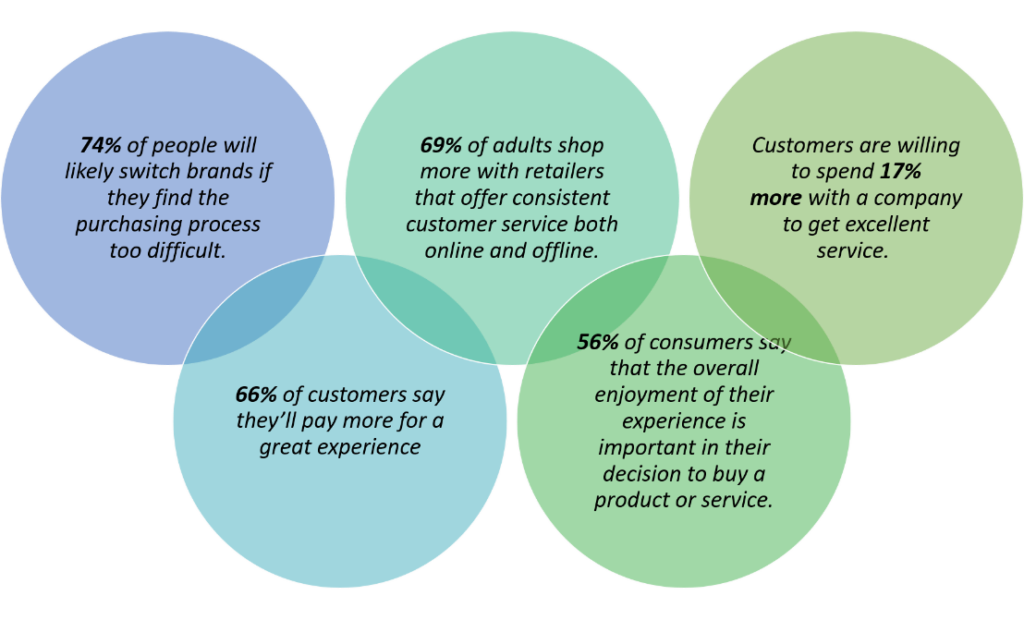
Key Customer Experience (CX) Strategies to drive conversions on your eCommerce Website

eCommerce business globally has grown the fastest than any other in the past decade or more. Global leaders like Amazon, Walmart, eBay, and others have grown manifold. Global eCommerce transactions are expected to top US$4.2 trillion in 2020 and reach more than US$6.5 trillion by 2023.
For many, just having an online business has been a boon in disguise during the pandemic as it let them survive one of the biggest economic downturns in the history of mankind.
However, it is no longer just sufficient to have an eCommerce website with a payment gateway and glittering products listed to attract customers to buy. Unless you are a premium brand like Apple that has a significant loyal base of customers else loyalty among consumers is difficult to gain in this multi-variate world of products and services.
If you own or operate an eCommerce business, then you must know that having a rich and engaging Customer Experience (CX) is vital to the success of your online business. But before you consider investing in CX, it’s imperative to understand what is CX , what are the ways to improve customer engagement and how it can help push the conversions on your online store.
The link between high-quality customer experience and conversion is indisputable. Brands that offer engaging CX see their conversions grow faster than those who don’t invest in CX as an enabler for growth.
Now that you are seemingly interested in CX, let us make it easier for you to understand it and give you some tried & tested tips to put it to use for your online business.
What is Customer Experience (CX)?
Customer experience or CX as it is popularly referred to is the influence your customers have of your brand as a whole during all phases of the customer’s journey. It affects their judgment of your brand and results in factors associated with your bottom line, including gross revenue across all your sales channels.
CX is the outcome of every communication a buyer has with an online store, from navigating the website to discovering the product/service to talking to customer service and receiving the product/service they purchased from a website. Everything we do influences customers’ judgment and their choice to keep coming back or not – delightful customer experience is the path to loyalty.
Why is customer experience (CX) necessary for eCommerce?
In the connection of eCommerce store and online retail store, customer experience applies to how a brand leads to engage its customers across the web.
Customer experience represents a customer’s perception of how a business interacts with them and vice versa. Whether it’s in-store, through mobile, or web, the perception developed based on their experience is the driving factor that influences customer behavior. It creates brand visions and promotes brand loyalty.
Think of CX as the fingerprints you leave on your customers. The entire journey— from the first impression to repeat purchases—is crucial. Hence, enterprises should estimate and anticipate every touchpoint of consumers who buys from you.
Delightful experiences encourage increased sales, lower returns, positive reviews and above all, loyal customers. Needless to say, bad customer experience leads to exactly the opposite.
If customers like interacting with your brand, they’ll recommend you to others and stay with you longer. In many cases, customer loyalty can last generations, or for the life of the brand, itself.
Isn’t ‘customer experience’ the same as ‘customer service’?
The fundamental distinction between customer service and customer experience is that customer experience involves the entire customer journey, including customer service. Customer service is limited to the interactions a customer has when requesting information or assistance on a product or service.
Recognizing the customer experience includes analysing data from non-customer-facing teams that contribute to a customer’s overall experience with a product or service. Here are some statistics gathered from various sources that quotes about the influence CX have on brands and businesses.

Source: https://www.helpscout.com/75-customer-service-facts-quotes-statistics/
From the above statistics, it clearly depicts why customer experience (CX) has become one of the most important and most widely-discussed topics in today’s online business world. CX is also difficult to master because no business can control all of the factors that influence customer experiences.
A business can control the attributes and characteristics of the environments presented to customers, and it has some control over what happens when they come across your website and go through their shopping journey. You can leverage your customer experience strategies but you don’t have a control on the effect of your CX strategies. The effect is largely determined by the context of the experience and by the customer’s psychological state, and these are the last things any company can control or “manage.”
We bring to you 10 best ways any eCommerce store should implement to leverage these CX practices to drive growth in conversions.
10 Best ways to improve online customer experience:
1. Deliver superior mobile experiences
Providing the best mobile eCommerce purchasing experience can profit retailers significantly. By 2021, mobile eCommerce sales are assumed to be accountable for 54% of overall e-commerce revenue.
This is one of the reasons why your online store should be effortlessly available on mobile devices and not just desktops and laptops.
Remember, that your mobile eCommerce site should be highly optimized. Think with Google reports that 53% of customers will drop from your website if it takes more than three seconds to load. When they bounce off from your website, possibilities are that they’ll go straight to your competitors.
If more than 30% of your site visitors visit using their smartphones, create a dedicated mobile app. Mobile apps are far more productive than responsive designs and offer a better customer experience.
Once your mobile app is in place, you’ll need a digital transformation approach to enhance and update processes and technical capabilities that will meet your customers’ demands.
A solution to this is using a digital identity platform. This is a reliable way to engage customers while the holiday season and beyond while enriching their digital experience.
2. Enhance website navigation (Product/Service Search)
Usually, online customers fall under three different categories based on an individual’s expectations, purposes and requirements. It includes the following:
People who already know what they are looking for –
Shoppers who know what they want will go directly to the product search bar. When strategically placed, your customers will easily find what they are looking for. You may also want to include auto-complete so you can help shoppers who can’t memorize the exact product name. This significantly improves the customer satisfaction on product discovery.
People who are browsing your eCommerce website –
Customers who scan your site need a variety of sorting options such as brand, colour, price and size. It would be best if you allowed them to personalize the search experience.
People who need assistance in filtering products –
These are visitors who have precise criteria for their product search but don’t often know what they want. You might want to include product features in the sorting options, so the filtering of products becomes more effortless. According to a research by SearchNode “site search can make or break your eCommerce website”.
3. Provide a secure and faster checkout Process
Keep it simple – this is easy. It is a necessity that you keep online transactions seamless and easy. Customers usually appreciate uncomplicated online purchases. Many eCommerce sites don’t give much attention to how difficult or smooth it could be to complete the checkout process.
So, how can you simplify the checkout process and be able to improve eCommerce customer experience?
Shopping Cart view – While buyers shop around, shopping carts must be clearly and easily accessible on every page. A window pop-up may prove to be helpful if a customer would like to add an item. This will notify them that they are about to add an item so they can confirm whether they wish to proceed with the checkout. Include prices and fees on the shopping cart. Avoid give a misleading experience to your customers in any way. All costs and charges applicable to the items the customers have selected, including shipping and tax fees, must be mentioned in their shopping cart.
Product recommendations – Always highlight any special offers that will allow customers to recommend a product and also save some money. Do make new products and recommended products clearly visible. Showing recommended products are essential for engaging the customer. If the product is going to be out of stock soon, you should highlight it and also incorporate an option for them to sign up for updates so they would know when the product is going to be available.
On the checkout page, make recommended products noticeable, particularly those that are related to what the customer has bought. These recommended products can boost up-sells and cross-sells. At times customer loses interest in the product that will be out of stock then divert this interest into something ‘related’ instead.
Multiple payment methods – Offer a wide variety of payment choices. You don’t want your shoppers to drop their items upon checkout just because the payment option they favored is not on the list. If you can, you should always offer a wide variety of payment options – especially those that are commonly used by many online customers. You are making things easier for them and at the same time, boost customer loyalty, which will ultimately lead to higher profits later on.
Offer Account Sign-up – Some of the most reliable eCommerce platforms offer an account sign-up option before they complete the transaction. However, this should not be mandatory because this could discourage the customer to do so, and the customer may abandon the checkout process entirely. Instead, requiring your customers to sign-up, you can provide them with options to create an account or continue checkout as a guest. Once they have completed the purchase, entice them to sign up by telling them that the entire checkout becomes so much more comfortable the next time around. You’re not risking cart abandonment this way.
Filling up shipping information – Allow your customers to pick whether they want the standard or the advanced form of shipping. Make the estimated date of delivery visible on this page after they have chosen their method of shipping. Make it easier for them to fill out the shipping information and do not, by any means, ask the customers to enter the shipping information twice. Instead, create checkboxes if the shipping address is the same as the billing address. Do this to other entries on the website if it is deemed necessary.
4. Improve customer service and satisfaction
eCommerce websites – just like conventional businesses – must have excellent customer service tips, in pages like checkout page or order confirmation email because they are specially designed for customers.
Just because you are providing customer service doesn’t necessarily mean you have to communicate personally with them. Nonetheless, make sure that all your contact information like email and telephone numbers are visible on every page of your eCommerce website. This gives your customers a way to keep in touch with you if they have any inquiries or concerns about the product they have purchased.
Do not overload your customers with the data they don’t need especially in the FAQ section. Only include necessary information. There are times when an overloaded FAQ section may deter the customers from making a purchase.
When customers do submit a ticket or call your support lines, you should be well-prepared to manage these tickets and concerns promptly and solve them on time. Any form of delay will only cause adverse feedback, which will risk losing your customers in the process.
Consider having self-service customer support – An excellent customer service support doesn’t necessarily mean a direct interaction. Some people prefer self-service because they don’t have to un-necessarily call support lines that will make them wait for the next available representative. Also, nobody likes to pick up their phones just to fix issues that otherwise they can do on their own. Therefore, offering them an alternative form of self-service support can benefit not only the customers but you as well. You reduce the workload of your support staff, you enlighten the customers and save on customer support expenses in the process.
5. Mobile strategy should serve customers at ALL touchpoints
Brick-and-mortar retail will always exist. It will only die if you let it, by not implementing a digital strategy with identity management that personalizes the journey for your customers.
Dollar General says that “digitally engaged customers” spend twice as much as the average checkout receipt. To address this, Dollar General began a comfortable “Order online and pick up at store” characteristic that analysts say could help draw a younger demographic.
In short, shoppers like to connect digital and mobile shopping with in-person buying experiences. That’s why retailers should include mobile-friendly touchpoints in their marketing strategies.
Here are strategies for improving customer experience in-store and online:
- Trigger relevant chat, email, or SMS workflows when users engage with mobile devices
- Include on-the-spot buyer guides, product fact sheets, and upselling suggestions on your sites and apps
- Use aggregate eCommerce data from customer identities to build marketing schemes
- Install in-store kiosks with complementary products, allowing users to compare items
- Synchronize profile and buying information between devices and physical locations by using customer identity and access management (CIAM) software
In short, integrating digital and traditional touchpoints using CIAM tools will help you build customer satisfaction and loyalty that lasts.
6. Enhance product, content and image quality on product pages
The apparent truth is that the primary purpose of any eCommerce website is sales. And a compelling product page makes all the difference between a sale and a quick bounce.
A product page should be an equivalent of communicating with a salesperson in the physical store. It should let your customers visualize themselves using the product.
A perfect product page should provide customers with detailed descriptions, high-quality images, video, FAQ, customer reviews and more.
That’s why an entire product page should be in line with the latest trends:
- Descriptive, specific titles
- Unique, vibrant and complete descriptions
- Detailed specifications and attributes to answer all the questions customers may have
- Prominent “Add to cart” and “Checkout” buttons
- High-resolution product image on a white background (with a zoom option)
- Appropriate meta information for images
- High-quality videos showing how to use the product
- Shipping information & return conditions
- Recommended products & accessories
- Customer reviews
- Pricing at a prominent position
- If you offer a discount, strikethrough the old price
7. Use personalization techniques to improve product discovery and recommendations.
Enabling your shoppers to have customized experience can improve how you do business online. By now you know, there are various types of customers visiting an eCommerce website.
You must include a clear Call to Action (CTA) that leads them to a page, which they can correlate. Use a friendly customer service tone throughout the pages of your eCommerce site so the buyers will always feel valued and important. Incorporating a personal touch to every page of your website is a must-have.
8. Leverage Social Media Networks and Integration
Despite your target audience, the current generation depends on promotions and communications done on social media channels like YouTube, Facebook and Twitter. Take benefit of these free social media platforms by building and improving strategies that will engage your customers. This process can make a significant impact in the success of your business and maybe a cost-effective solution to marketing. Moreover, social media channels are quick communication networks that will enable you to deal with customer issues or inquiries faster than ticket submission or calling customer assistance. When implemented correctly, you can achieve a better eCommerce customer experience that will ultimately increase revenue and loyalty.
9. Include Customer and Product Reviews
Customer reviews are excellent ways to notify potential customers what items sell best and are of superior performance and quality. Potential customers read reviews a lot, and it can help the buying process making it more comfortable and more convenient to decide. People appreciate feedback from real customers who have purchased and used the same product. Make sure that your customers can see these reviews prominently on the product page that they are viewing. This review section can significantly influence the customers’ decision to buy the item or redirect their attention unto a related item.
10. Personalize Your Marketing communications
Marketing automation tools help enterprises to streamline their marketing methods. By automating marketing tasks, it becomes much easier to increase your market reach, generate leads, build customer relations and drive conversions. As any company grows, it’s impossible to handle every single lead and consumer manually.
Marketing automation tools move consumers through the marketing funnel with ease. It ensures your prospects with a consistent experience across multiple digital marketing channels.
By leveraging a marketing automation tool, you can personalize the customer experience by providing the most precise information and promotions to customers with diverse needs.
In summary, digital technology progressions are transforming customer expectations making them seek rich, interactive, and engaging customer experiences. As user perception becomes paramount, poor or rushed design doesn’t make it anymore. Today, customer experience goes beyond on-screen design. Comfortable buying journey, omnichannel support, and positive experience at every touchpoint have become essential to ensure customer retention.
At Apexon, we enable our clients to create value by putting customer experience at the core of everything. We help our clients master the capacity to meet millions of customers across various touchpoints, and yet treat every customer as one. We enable eCommerce enterprises to:
- Link every journey to create consistent and intuitive omnichannel experiences.
- Make responsiveness a fundamental design element and get micro-moments right.
- Enhance customer understanding using analytics, artificial intelligence, and mobility.
- Analyze the path to purchase and customer behaviour to customize offerings.
- Create personalized product recommendations.
- Build Omnichannel experience for B2C and B2B customers.
- Utilize UX design to answer challenging problems and find opportunities to go beyond initial thinking.
Reach out to us and learn more about leveraging the best practices of customer experience for your eCommerce business.




